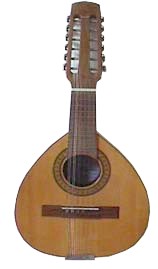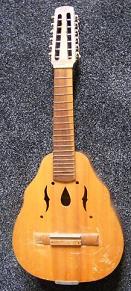|
|
|||||
|
|
What is a Bandurria The bandurria is a Spanish stringed musical instrument of the lute family, with a design derived from the cittern and guitar. In the Medieval period, it apparently had three strings. During the Renaissance they gained a fourth string, and during the Baroque period this changed to 5 pairs. The modern bandurria has 12 strings (6 courses). The strings are tuned in unison pairs, the lowest four strings a major-third and the highest two strings a fourth above a standard guitar, to G#, c#, f#, b, e and a. It has a small, pear-shaped or teardrop wooden body, a short neck, and a flat back. The fingerboard has 12 fixed metal frets, and unlike the mandolin, it has a fixed bridge. Assuming this tuning, middle C should be 4th fret on 6th string.
|
|
|||
|
|
The Laud The la�d (tenor lute) is a plectrum plucked instrument from Spain. It belongs to the cittern family of instruments. It has six double courses ( twelve strings in pairs), similarly to the bandurria, but its neck is longer. Traditionally it is used folk string musical groups, together with the guitar and the bandurria. The origin of the laud (tenor lute) is the modern spanish lute of the XIX century. There are several models, such as the pear-shaped and the Calvete. Like the bandurria, it is tuned in fourths, but 1 octave lower. The strings are tuned in unison pairs, to G#, c#, f#, b, e and a. Assuming this tuning, middle C should be 1st fret on 3rd string. |
|
|||
|
There is a lot more information on another site, here... Bandurria FAQ |
|||||



